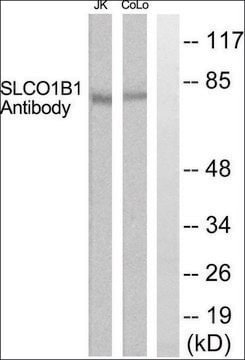일반 설명
We are committed to bringing you greener alternative products, which adhere to one or more of The 12 Principles of Green Chemistry.This antibody is Preservative-free, produced without the harm or sacrifice of animals and exceptionally stable to allow for ambient shipping and storage if needed and thus aligns with "Waste Prevention", "Designing Safer Chemicals" and "Design for Energy Efficiency".
Click here for more information.
ZooMAb® antibodies represent an entirely new generation of recombinant monoclonal antibodies. Each ZooMAb® antibody is manufactured using our proprietary recombinant expression system, purified to homogeneity, and precisely dispensed to produce robust and highly reproducible lot-to-lot consistency. Only top-performing clones are released for use by researchers. Each antibody is validated for high specificity and affinity across multiple applications, including its most commonly used application. ZooMAb® antibodies are reliably available and ready to ship when you need them.
특이성
Clone 1E22 is a ZooMAb® rabbit recombinant monoclonal antibody that specifically detects CAM Kinase II Delta. It targets an epitope within 24 amino acids from the C-terminal region.
면역원
KLH-conjugated linear peptide corresponding to 24 amino acids from the C-terminal region of human CAM Kinase II Delta.
애플리케이션
Quality Control Testing
Evaluated by Western Blotting in L6 cell lysate.
Western Blotting Analysis: A 1:10,000 dilution of this antibody detected CAM kinase II Delta in L6 cell lysate.
Tested Applications
Western Blotting Analysis: A 1:1,000 dilution from a representative lot detected CAM kinase II Delta in lysates from HeLa, Fetal bovine heart endothelial (FBHE),, and C2C12 cells..
Immunohistochemistry (Paraffin) Analysis: A 1:100 dilution from a representative lot detected CAM kinase II Delta in Human heart tissue sections.
Immunofluorescence Analysis: A 1:100 dilution from a representative lot detected CAM kinase II Delta in Human heart tissue sections.
Affinity Binding Assay:: A representative lot of this antibody bound CAM kinase II Delta peptide with a KD of 8.4 x 10-6 in an affinity binding assay.
Note: Actual optimal working dilutions must be determined by end user as specimens, and experimental conditions may vary with the end user.
표적 설명
Calcium/calmodulin-dependent protein kinase type II subunit Delta™(UniProt: Q13557; also known as EC:2.7.11.17, CaM kinase II subunit Delta™, CaMK-II subunit Delta™) is encoded by the CAMK2D (also known as CAMKD) gene (Gene ID: 817) in human. CaM kinase II is a complex of about 12 subunits that exist in four differentially expressed forms (α, β, γ, δ). The α and β isoforms are most abundant in neurons, whereas γ and δ isoforms are expressed in most tissues. The δ isoform is the most prominent isoform in cardiomyocytes. CaM Kinase II δ is a peripheral membrane protein that in its inactive state exhibits a strong interaction between its inhibitory (aa 283-292) and catalytic (aa 14-272) domains. Its CaM-binding region is localized in amino acids 291-301. The binding of Ca2+/CaM allows the catalytic domain to phosphorylate the inhibitory domain. Once activated, CaM kinase II retains significant activity even after the withdrawal of Ca2+, thereby prolonging the duration of kinase activity. This is attributed to the capacity of the enzyme to remain phosphorylated in the absence of Ca2+. CaM Kinase II δ is involved in the regulation of Ca2+ homeostasis and excitation-contraction coupling (ECC) in heart by targeting iOn™ channels, transporters, and accessory proteins involved in Ca2+ influx into the myocyte, Ca2+ release from the sarcoplasmic reticulum (SR), SR Ca2+ uptake, and Na+ and K+ channel transport. In its activated form, it is involved in the pathogenesis of dilated cardiomyopathy and heart failure and is known to contribute to cardiac decompensation and heart failure by regulating SR Ca2+ release via direct phosphorylation of ryanodine receptor (RYR) 2 Ca2+ channel on serine 2808. CaM Kinase II δ undergoes autophosphorylation on threonine 287 following activation by Ca2+/CaM, which locks the kinase into an activated state. This ZooMAb® recombinant monoclonal antibody, generated by our propriety technology, offers significantly enhanced specificity, Affinity™, reproducibility, and stability over conventional monoclonals. (Ref.: Rose, AJ., et al. (2006). J. Physiol. 574(3); 889-903; Gaertner, TR., et al. (2004). J. Biol. Chem. 279(13); 12484-12494).
물리적 형태
Purified recombinant rabbit monoclonal antibody IgG, lyophilized in PBS, 5% Trehalose, normal appearance a coarse or translucent resin. The PBS/trehalose components in the ZooMAb formulation can have the appearance of a semi-solid (bead like gel) after lyophilization. This is a normal phenomenon. Please follow the recommended reconstitution procedure in the data sheet to dissolve the semi-solid, bead-like, gel-appearing material. The resulting antibody solution is completely stable and functional as proven by full functional testing. Contains no biocide or preservatives, such as azide, or any animal by-products. Larger pack sizes provided as multiples of 25 µL.
재구성
300 µg/mL after reconstitution at 25 µL per vial. Please refer to guidance on suggested starting dilutions and/or titers per application and sample type.
저장 및 안정성
Recommend storage of lyophilized product at 2-8°C; Before reconstitution, micro-centrifuge vials briefly to spin down material to bottom of the vial; Reconstitute each vial by adding 25 µL of filtered lab grade water or PBS; Reconstituted antibodies can be stored at 2-8°C, or -20°C for long term storage. Avoid repeated freeze-thaws.
기타 정보
Concentration: Please refer to the Certificate of Analysis for the lot-specific concentration.
법적 정보
Affinity is a trademark of Mine Safety Appliances Co.
Delta is a trademark of Heathrow Scientific LLC
ZooMAb is a registered trademark of Merck KGaA, Darmstadt, Germany
iOn is a trademark of 3DXTech
면책조항
Unless otherwise stated in our catalog or other company documentation accompanying the product(s), our products are intended for research use only and are not to be used for any other purpose, which includes but is not limited to, unauthorized commercial uses, in vitro diagnostic uses, ex vivo or in vivo therapeutic uses or any type of consumption or application to humans or animals.









